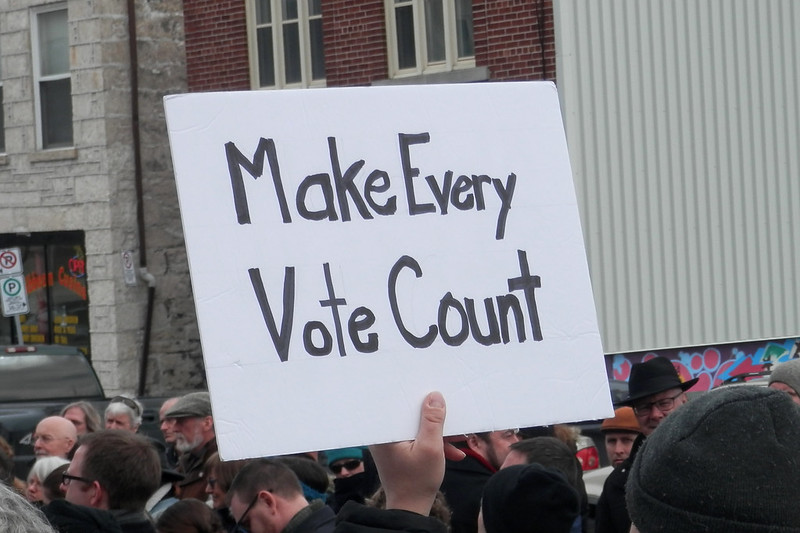Ever since Confederation in 1867, Canada’s federal election process has revolved around the first past the post system. The law for federal elections is incorporated within the Canada Elections Act. The Act provides a description of the process of electing members to the House of Commons. The Canadian constitution itself does not state which electoral system must be utilized when electing members to the House of Commons. Therefore, if need be, the electoral process may be altered and replaced with a new system. The discussion of electoral reform has gained more traffic in recent years as individuals begin to believe our system is outdated. Other democratic countries have reformed and altered their systems to better represent their electorate.
During the 2015 federal elections, Justin Trudeau stated that the 2015 federal election would be the last election performed using the first past the post system. However, on December 2016, the Trudeau government refused to launch a national referendum to determine whether to launch electoral reform or not, resulting in the failure to keep this electoral promise. By analyzing the first past the post (FPTP) system and examining alternative electoral systems: proportional representation (PR) and mixed member proportional (MMP), I will suggest an alternative system that would benefit Canada and its citizens.
Understanding First Past the Post
Canada’s federal election process utilises the first past the post system. The FPTP system is a historical parliamentary system developed by the British. It falls within an overarching family of political systems known as majoritarian systems, in which the party that receives the most votes is the winner. Depending on the rule set, an individual may require a plurality of votes or a majority to win in a district.
Canada’s FPTP system begins with Section 51 of the Constitution Act, 1867. The Act is incorporated with a formula that allocates a certain number of seats per province and territory. Currently, there are 338 seats in the House of Commons, allocated to provinces and territories based on population size. The provinces and territories are divided into districts, each represented by a single member of Parliament. Under the FPTP electoral system, each elector casts one vote for candidates who aim to represent their district in the House of Commons. The political actor who receives a plurality of votes in her district represents her district within the House. The party that obtains the greatest number of seats is invited by the Governor General to form government, assuming the party can maintain confidence.
The FPTP system is favoured by many democracies as it ensures democracies run smoothly as it promotes the election of stable majority governments. This allows governments to execute their legislative agenda without the constant fear of losing confidence within the house and helps save time in decision making. The FPTP system is very simple and easy to understand. The system produces clear winners and the system utilises one of the simplest ballots. The results are very easy to tally, minimizing costs. The system promotes the service of the people as public support determines who is within power. The link between electors and members is strong as members aim to represent their constituency as best they can to win further elections. The system promotes political actors who represent their people.
Although the system has many advantages, it is not perfect. The largest complaint individuals hold against the FPTP system is that it produces a disproportionality between number of votes received and number of seats awarded. Due to its winner-takes-all nature, FPTP often rewards the winning party a seat bonus; a greater share of seats, relative to its shares of the popular vote. As a result, other parties experience seat deficiencies. Canada’s electoral system is often ranked as one of the most disproportional systems within western democracies. Parties can win majority government with about 40% of popular vote, however at the same time, parties can win 20% of the popular vote and receive a small fraction of the seats in the House of Commons. It is also possible for seat bonuses to produce false winners. In some cases, the party with the second largest share of votes can claim more seats than the most supported party.
The winner-takes-all nature of the FPTP system also encourages parties to nominate safe candidates. This results in the underrepresentation of minority groups, indigenous people, and women within the House. The system discourages voters as votes supporting the winner of elections only hold weight in determining outcomes. The system amplifies regionalism, rewarding region specific political parties and hurting political parties with dispersed political support. As a result, large parties such as the Liberals and Conservatives benefit, whereas small parties such as Green Party and independents suffer. The NDP, a large party with dispersed political support, suffers under this system. Regionalism also leads to a waste of votes. Minority governments do not fare well under the FPTP system. Between 1957-2005, only one of Canada’s seven minority governments remain in power for more than two years. Parties are incentivised to dissolve government and trigger an election when they can win a majority.
Proportional Representation
Proportional representation systems are the most prominent electoral systems in the world. They first appeared during the 1840s election in Adelaide, Australia. They aim to allocate seats in the legislature, closely to the vote share. Unlike plurality systems like the FPTP system, the electorate votes for multiple representatives per district.
The proportional representation systems family includes open and closed-list proportional representation, single transferable vote, and single non-transferable vote. Under the open-list proportional representation, voters vote for candidates from party lists, creating a ranking. Seats are then allocated to individuals, based on their list ranking, proportional to overall party support. In the closed-list proportional representation system, parties create lists ranking candidates. The electorate votes for parties, allocating seats to parties via vote share. Candidates are then assigned according to their ranking on the party lists. The single transferable vote system requires citizens to rank multiple candidates within their district. Candidates who meet the vote quota based off first preference are assigned a seat. If more seats are to be filled, votes excess of the quota are assigned to the second preference indicated on the ballots: excess transfer. Those who now meet the quota are elected. If no representative is elected, the candidate with the least amount of first preferences is dropped and the second preferences are given the votes. This process continues until all seats are filled. In the single non-transferable vote system, individuals vote for one candidate within their district. Candidates with the highest votes are elected.
PR systems are the most utilized forms of government. PR systems must exhibit many benefits to be preferable over other systems. The defining characteristic of PR systems is their ability to accurately assign seats according to party vote shares. This allows elections to create representative governments. It is believed that Europe’s adoption of PR is due to unrepresentative electoral results, resultant of the FPTP system. Proportional representation leads to the greater representation of smaller parties. Smaller parties often have more dispersed support, making it difficult to win under FPTP. PR provides greater choice as individuals can vote for multiple candidates. The likelihood of a party to receive more than 50% of votes is low, promoting minority governments. The minority governments create multi-party systems in which a greater diversity of perspectives is heard. The system tends to lead to the incorporation of parties to the right, left, centre and other alternative parties such as the Green Party. The PR system increases the likelihood of representation of underrepresented groups in Parliament. Parties can use party lists to increase the chance of members of underrepresented groups to gain access to parliament.
No political system is without its cons, even PR. PR systems can be complex and difficult to understand; the allocation of extra votes is tricky. The ballot can be long and complex, increasing the difficulty of voting. The link between members and assigned regions become less prominent as the number of representatives increase. Individuals with extreme views are also more likely to be elected, such as the Bloc Québécois. Supporters of extreme views are more likely to be found dispersed through the country as well. Therefore, PR increases accessibility to Parliament. The reallocation of votes increases the election process.
Mixed Member Proportional
After WWII, the mixed electoral systems emerged in Germany. These mixed electoral systems are a hybrid of majority systems and proportional representation. The mixed member proportional system falls within the family of mixed electoral systems. Within the MMP system, individuals cast two votes; one to vote for a representative to represent their constituency and one for a party. Majority of the legislature is determined by the first vote; a FPTP method—the plurality vote. The second vote is used to balance the seats to closely match party vote shares. Using party lists, the system allocates seats to parties to compensate for the disproportional results from the plurality vote. Additional seats are assigned to parties who fail to obtain seats reflecting their voter support.
As a hybrid system, the MMP system shares advantages and disadvantages with the PR system and FPTP system. Like the PR systems, the MMP outcomes results in proportional representation. The link between constitutes and their members is preserved as a single representative is assigned per district. This system allows for greater choice as the electorate can vote for different parties in both votes. The allocation of votes according to voter share increases the opportunity of smaller parties to obtain seats in Parliament. The system promotes multi-party legislatures as it is not common for parties to obtain more than 50% of the vote. Coalition governments are common and are quite stable. Minority governments also do not struggle to survive. The system allows willing parties to aid underrepresented communities by placing candidates from such groups higher on their party lists. Though the pros are fruitful, the system is very complex and difficult to understand. It also creates two member classes: electoral district and list. Nonetheless, the MMP system’s pros clearly outweigh the cons.
Promoting Electoral Reform – Switch to Mixed Member Proportional
In December 2014, the mixed member proportional system was presented to the House of Commons. The model gained the support of the NDP, Green, half the Liberal MPs and Conservative independent Brant Rathgeber. However, the electoral reform was rejected. The system is beneficial in terms of creating a representative democracy that reflects the preferences of the Canadian citizens. Many Canadians face the dilemma of wanting to support a party, but not their local candidate and vice versa. The MMP system solves this issue as it allows electors to vote separately for preferred local candidates and preferred parties. The separation allows individuals to vote for their preferred party federally, without giving up their preferred local representative.
Our current FPTP system is integrated well into the minds of Canadians, however the transition to MMP should not cause difficulty. The system is simple and easy to use. It also builds on the current system as MMP is a hybrid system that incorporates the FPTP system. The MMP system provides the benefits of the proportional system. It allows seats to be allocated in a way that reflects the party’s share of votes. The MMP gives small and medium parties easier access to seats in Parliament. The secondary vote, vote for party, in the MMP system limits the impact of party monopolisation of regions. The votes will not count only towards the winner of the election, but also to the overall election results eliminating wasted votes. Central Canada tends to determine the outcomes of elections. A shift towards MMP system may limit the impact Ontario and Quebec hold on federal elections as parties who have widespread support can gain seats through the secondary vote.
Individuals often argue that MMP leads to the formation of inefficient governments because it decreases the possibility of obtaining majority governments. Canada does not have a great record of successful minority governments. Between 1957-2005, only one of Canada’s seven minority governments remained in power for more than two years. However, it is argued that this is because minority governments do not fare well in FPTP systems. Due to the structure of the Canadian political systems, parties often dissolve minority governments when they believe they can win a majority.
Under MMP systems, the likelihood of dissolving government diminishes. When analysing European countries utilizing PR and MMP systems, findings show that the parties adapt to the minority government system and learn to cooperate. As a result, minority governments become more stable over time. Though one-party governments run more smoothly, majority governments prevent collaboration within the House of Commons. When analyzing the best governments, analysts agree that most efficient governments are those lacking a majority. In majority governments, the governing party can ignore inquiries made by the opposition. Opposing parties are unable to keep the ruling party in check. The MMP is effective at encouraging voters to vote and fosters increased civility. The incorporation of PR within the MPP leads to a higher incorporation of minorities.
In Canada, 26% of the seats are occupied by women. This places Canada at 62nd worldwide in terms of female representation in Parliament. The probability of a woman running for office to be elected is slightly less than a male candidate, however the representation of women is limited. According to a 2004 report by the Law Commission of Canada, the underrepresentation is a direct result of the FPTP system utilized by Canada. The winner-takes-all nature of the Canadian electoral system encourages parties to utilize ‘safe’ candidates to maximize their probability of winning elections. The system discourages parties from putting forward females and representatives from minority groups. This is evident from research published in Electoral Studies, which finds that 60% of female candidates run in opposition party strongholds.
According to many experts, electoral systems are the primary element in influencing female representation. Proportional representative systems are often labelled as the most favourable systems to female candidates. Data suggests that list seats do boost the chances of female and minority candidates to gain access in Parliament. For example, historically, the majority of women who serve in the German Parliament are elected through list seats. Due to the incorporation of PR in MMP, MMP also can increase representation.
Mixed electoral systems such as the MMP system are often lauded for their ability to promote the election of minority and female candidates. If underrepresented candidates face difficulties in getting elected, parties can guarantee they are elected using party lists. This is quite evident in New Zealand’s electoral reforms. In 1993, New Zealand shifted from a FPTP system to an MMP system. The impact of the electoral reform was immediate as the representation of women in Parliament increases from the peak of 21% under the FPTP system to 28%. Under the MMP system, gender quotas are also easier to implement. Utilizing party lists, quotas are easier to facilitate and implement, unlike majority systems where parties are unable to control which candidates win. Parties can utilize methods such as the zipper system; alternating male and female candidates on the party list, to ensure there is an equal representation in Parliament. Political scientists often describe gender quotas as the “single most effective tool for ‘fast tracking’ women’s representation in elected bodies of government”.
Conclusion
The Canadian electoral system follows an outdated British model. In the 21st century, the FPTP system is unable to develop a government that can effectively represent the people. Canada is victim to the governing by two powerful parties that benefit from the current electoral system, making electoral reform seem unlikely. The mixed member proportional system is an electoral system with an abundance of pros that outweigh the cons. It incorporates FPTP and PR, creating a hybrid system. This hybrid incorporates the benefits of both electoral systems while eliminated many of the drawbacks of FPTP. In today’s world, almost all democracies incorporate some form of proportional representation in their electoral system. Of the 36 democracies worldwide with populations greater than two million, Canada, Jamaica and the United States are the only ones that do not utilize some form of PR. The movement away from pure FPTP has begun. It is in Canada’s best interest to move towards newer electoral systems that better reflect the needs of 21st century citizens.
Photo: Rally for electoral reform at Lloyd Longfield’s office in Guelph, Ontario, Canada on Feb 11th, 2017, by Ryan Hodnett via flickr. Licensed under CC BY-SA 2.0.
Disclaimer: Any views or opinions expressed in articles are solely those of the authors and do not necessarily represent the views of the NATO Association of Canada.




